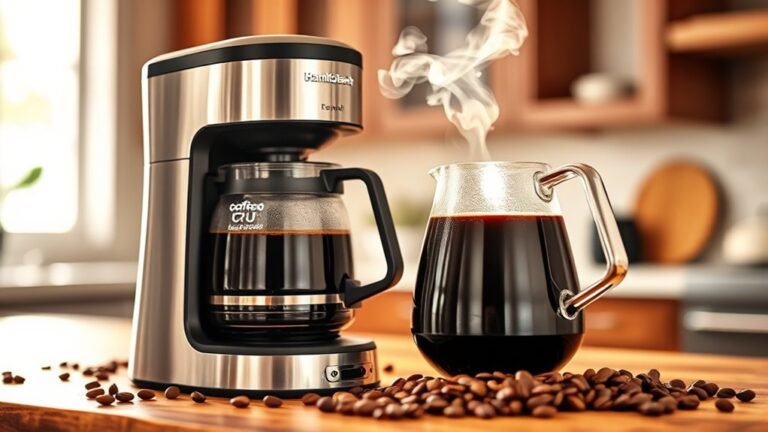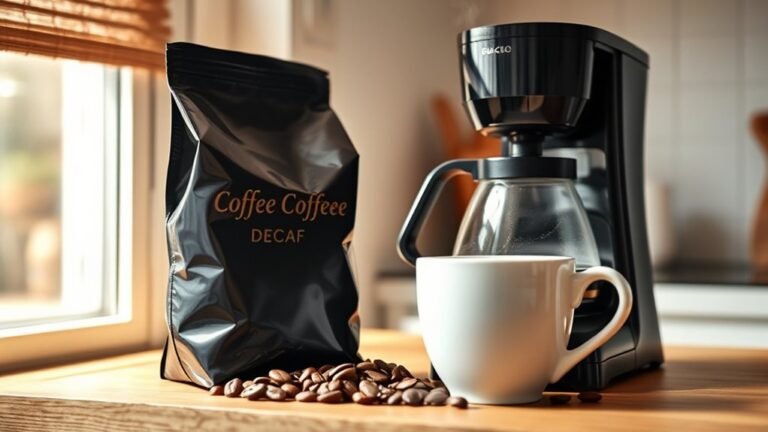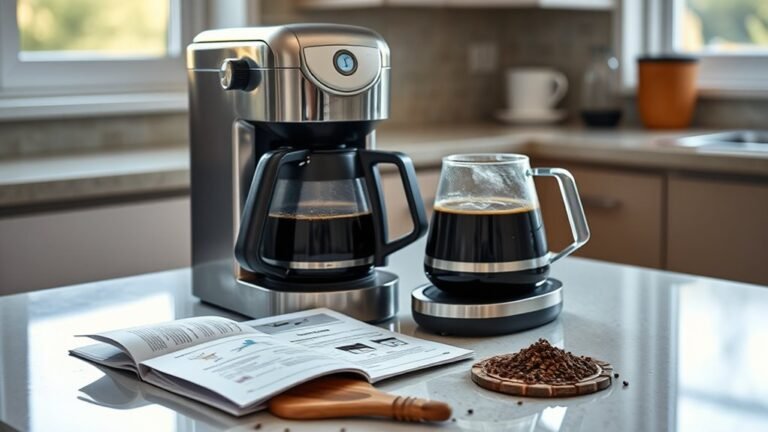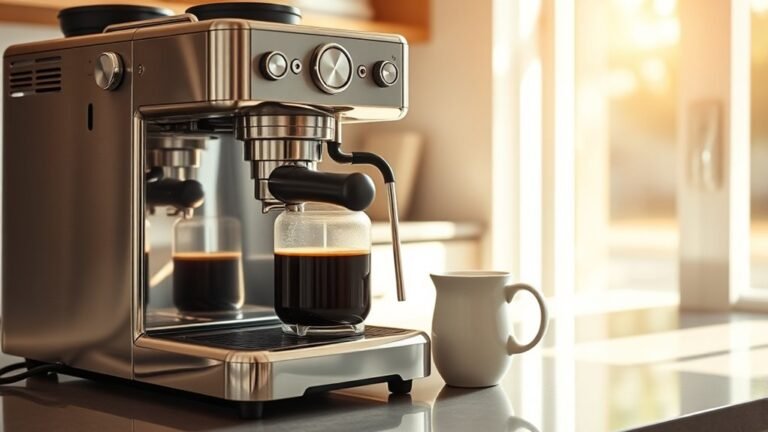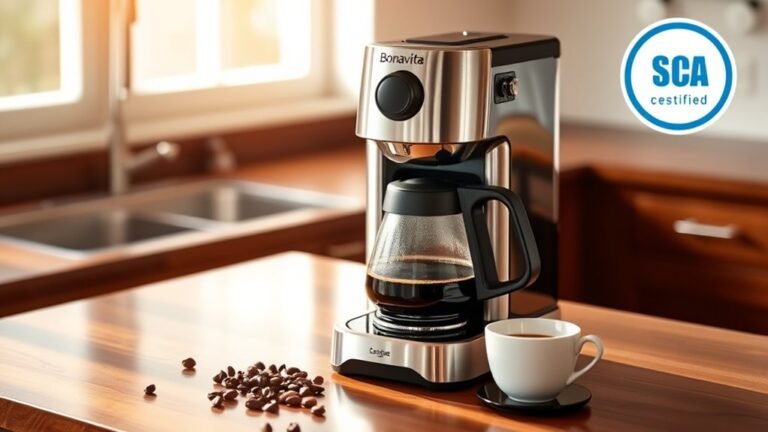The Evolution of the Espresso Machine
You’ve seen espresso machines evolve from manual steam boilers, which struggled with pressure and flavor control, to lever machines giving you precise, mechanical pressure for rich extraction. Then came electric pumps that guaranteed consistent temperature and flow, making espresso easier to master. Automatic and super-automatic models added convenience by combining grinding, brewing, and frothing, while smart tech now lets you customize settings via apps. If you want to explore the full journey and technology behind these advances, keep going.
Early Innovations in Espresso Brewing

Although espresso as it is understood today wouldn’t emerge until the early 20th century, the groundwork was laid by a series of mechanical and thermal innovations in the late 1800s. You’d first encounter manual brewing techniques emphasizing control over extraction, which paved the way for more intricate machinery. Inventors experimented with steam pressure to force hot water through finely ground coffee, aiming for a quicker, richer brew than traditional methods allowed. These early devices used steam boilers, but controlling steam pressure precisely proved challenging, often resulting in inconsistent flavors. Still, this struggle for mastery over thermal dynamics and mechanical pressure was essential. It’s this pursuit of freedom from slow, imprecise brewing that set the stage for the espresso machines you value today—machines that balance power and finesse, offering you liberation through a perfect cup.
The Rise of Lever Machines
Once inventors overcame the challenges of steam pressure control, the next breakthrough came with the introduction of lever machines in the early 20th century. These machines gave you direct control over brewing pressure through lever mechanics, allowing you to manually force water through coffee grounds. This hands-on approach empowered you to fine-tune extraction by adjusting the lever’s force and speed, unlike earlier steam-driven models that lacked precision. The first lever machines created a more consistent, richer espresso by stabilizing pressure without relying on fluctuating steam. As you operated these machines, you experienced newfound freedom to influence flavor profiles and crema quality. This evolution marked a turning point, where the barista’s skill became central, and brewing pressure was no longer left to chance but harnessed through deliberate, mechanical input.
The Advent of Electric Espresso Machines
As espresso culture grew, inventors sought ways to simplify the brewing process while maintaining control over pressure and temperature. In the early 20th century, electric advancements revolutionized espresso machines by replacing manual lever systems with electric pumps. This shift allowed you to achieve more precise pressure control, enhancing brewing consistency with every shot. By automating water flow, these machines freed you from the physical effort of pulling levers, giving you more freedom to focus on flavor nuances. Over time, improved electric components stabilized temperature, further refining extraction quality. This evolution marked a pivotal step, transforming espresso preparation from a skilled craft into an accessible routine without sacrificing control. The advent of electric espresso machines truly empowered you to enjoy consistent, barista-quality espresso with greater ease and reliability.
The Era of Automatic and Super-Automatic Models

Building on the precision electric pumps introduced earlier, automatic and super-automatic espresso machines emerged to further simplify the brewing process while maintaining quality. In the 1970s, automatic features like volumetric dosing allowed you to control shot length effortlessly, freeing you from manual timing. Soon after, super-automatic models integrated grinding, tamping, brewing, and even milk frothing into one seamless operation. This super automatic convenience meant you could enjoy café-quality espresso with minimal effort and no specialized skills. As these machines evolved, they balanced user control with automation, offering programmable settings that adapt to your preferences. By embracing automation, you gain freedom from repetitive tasks without sacrificing the rich flavors and textures you expect. The era of automatic and super-automatic machines truly transformed espresso-making into an accessible, consistent, and enjoyable daily ritual.
Smart Technology and the Future of Espresso Machines
While automatic and super-automatic machines revolutionized espresso-making by simplifying complex tasks, the integration of smart technology is taking this evolution even further. Today, smart features like app connectivity and voice control let you customize every detail from grind size to temperature, all from your phone. User interfaces have become intuitive, providing real-time feedback and maintenance alerts that keep your machine in peak condition without hassle. This shift empowers you to craft café-quality espresso with unprecedented freedom, tailoring each shot to your exact preferences. Looking ahead, expect machines to integrate AI, learning your habits and suggesting personalized settings. As smart technology advances, espresso machines will become more than appliances—they’ll be intelligent partners in your daily coffee ritual, enhancing convenience while preserving the artistry of espresso-making.
Frequently Asked Questions
How Does Water Temperature Affect Espresso Extraction?
You’ll find that water temperature significantly impacts espresso extraction by influencing brewing time and how water chemistry interacts with coffee grounds. If the water’s too cool, extraction slows, resulting in underdeveloped flavors. Too hot, and you’ll over-extract, causing bitterness. Ideally, you want a balanced temperature around 90-96°C to optimize solubility and brewing time, giving you the freedom to craft espresso that’s rich, smooth, and perfectly balanced every time.
What Is the Best Type of Coffee Bean for Espresso?
Choosing coffee beans for espresso is like picking the perfect dance partner—you want harmony and balance. Arabica beans offer a smooth, nuanced flavor with sweet and fruity notes, making them a popular choice. Robusta beans bring a stronger, more bitter kick and more crema. Many roasters blend both to achieve depth and boldness. You’ll find freedom in experimenting with ratios to match your taste, crafting your ideal espresso experience.
How Often Should an Espresso Machine Be Cleaned?
You should stick to a regular cleaning frequency to keep your espresso machine in top shape. Start by rinsing the portafilter and group head daily to avoid buildup. Weekly, backflush with a cleaning detergent to clear oils and residue. Don’t forget descaling every 1-3 months, depending on water hardness. These maintenance tips guarantee your machine runs smoothly, giving you the freedom to enjoy consistently great espresso without unexpected breakdowns or flavor issues.
Can Espresso Machines Be Used for Other Coffee Drinks?
Think of an espresso machine as your coffee Swiss Army knife—its espresso versatility lets you craft a variety of coffee drinks beyond just espresso shots. Starting with a rich espresso base, you can create lattes, cappuccinos, macchiatos, and more by steaming milk or adding water. This flexibility means you’re not confined to one style; your machine empowers you to explore and enjoy a spectrum of coffee experiences, tailored to your mood and taste.
What Are the Environmental Impacts of Espresso Machine Production?
When you look into espresso machine production, you’ll find that using sustainable materials helps reduce environmental harm from the start. Early stages involve mining metals, which isn’t eco-friendly, but choosing recycled or renewable components changes that. Throughout manufacturing, energy consumption spikes, especially in metal processing and assembly. If you demand freedom in your choices, picking brands prioritizing green energy and sustainable sourcing lets you enjoy coffee without harming the planet.

